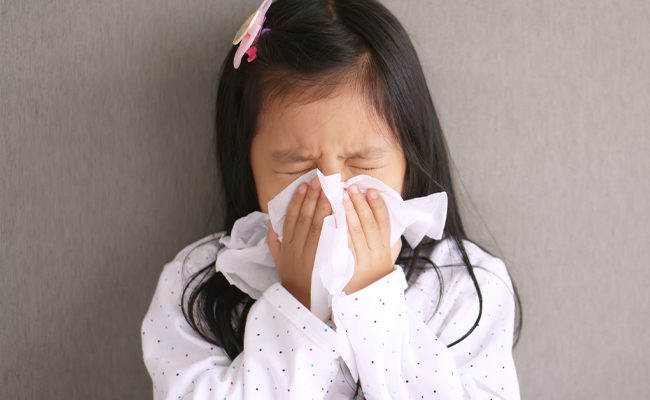Flu season is here, and it’s time to take steps to protect your child from the virus. But even with the best preventative measures, sometimes the flu can strike. Knowing how to treat the flu at home for a child can help ease their symptoms and get them back on the road to recovery. In this blog, we’ll cover flu symptoms in kids, flu treatment for kids, and more.
Symptoms of Flu in Kids
The flu is different from a common cold or a stomach bug. Flu symptoms in kids can include:
- Chills
- Fever
- Body aches
- Congestion or runny nose
- Loss of appetite
Children under the age of five, those with weakened immune systems, and those with asthma may be at a higher risk for serious complications from the flu. If your child falls into any of these high-risk categories, seek medical treatment immediately.
Cold Versus Flu Symptoms in Children
Your child has a running nose, a scratchy throat, and is more tired than usual. How can you tell if they have a cold or the flu? Cold and flu share many similarities, so it can be difficult to tell the difference between them when your child develops symptoms.
Knowing this, we have put together an overview of cold symptoms and flu symptoms to help you tell the difference.
If your child has a cold, they will likely have symptoms like these:
- runny or stuffy nose
- sore throat
- sneezing
- cough
- headache or body aches
- mild tiredness
If your child has the flu, they will likely have symptoms like these:
- dry, hacking cough
- moderate to high fever
- sore throat
- chills
- severe muscle or body aches
- headache
- runny or stuffy nose
- severe fatigue
- nausea and vomiting
- diarrhea
Flu Treatment for Kids
Many children can recover from the flu at home with some TLC. While the most severe symptoms usually subside in two or three days, it can take up to two weeks for your child to fully recover. Here are some tips for treating the flu at home for a child:
- Hydrate: Make sure your child drinks plenty of water or noncaffeinated drinks. Ice pops and watery fruits such as grapes or oranges can also help keep them hydrated.
- Sit Upright: Congestion can make it hard for your child to breathe. Encourage them to sit up while they’re awake, and prop them up on pillows at night to help drainage.
- Avoid Aspirin: Offer Ibuprofen or acetaminophen to help reduce fever and relieve aches. However, never give your child aspirin during the flu, as it can trigger Reye syndrome. Always follow your physician’s advice.
- Fight Congestion: Use saline rinses to loosen mucus from your child’s nasal passages. A humidifier can also help loosen mucus and make breathing easier.
When to Seek Medical Treatment
In some cases, home treatment may not be enough to ease your child’s symptoms. Contact your pediatrician if your child experiences any of the following:
- Difficulty breathing
- Severe vomiting
- High fever with a rash
Treating the flu is important to prevent serious complications, such as pneumonia or dehydration. If your child needs medical attention, schedule a sick child visit with the Youth Clinic by calling (970) 482-2515.
Flu Treatment Comparison Table
To help you compare different flu treatment options for children, we’ve created a knowledge graph that outlines the benefits and drawbacks of each option.
| Treatment Option | Benefits | Drawbacks |
|---|---|---|
| Hydration | Helps prevent dehydration | Does not directly treat flu symptoms |
| Sitting Upright | Helps with congestion and drainage | May not be comfortable for the child |
| Ibuprofen or Acetaminophen | Reduces fever and relieves aches | Use appropriate dosage for age and size |
| Saline Rinses | Loosens mucus from nasal passages | Can be uncomfortable for the child |
| Humidifier | Loosens mucus and makes breathing easier | Make sure to clean regularly to avoid spreading mold or bacteria in the air |
Conclusion
Knowing how to treat the flu at home for a child can help ease their symptoms and get them back to their normal routine. By keeping your child hydrated, propping them up while they sleep, using over-the-counter medications carefully, and treating congestion with saline rinses or a humidifier, you can help your child recover more quickly. If your child experiences difficulty breathing, severe vomiting, or high fever with a rash, contact your pediatrician.


